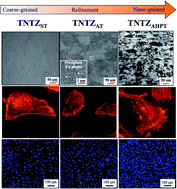Developing biomedical nano-grained β-type titanium alloys using high pressure torsion for improved cell adherence†
Abstract
Proper surface characteristics for a titanium implant are crucial for the formation of different cellular protrusions known as filopodia and lamellipodia, both of which have a significant impact on cell attachment, spreading, migration, and proliferation. Microstructural features such as grain boundaries and defects of implant surface can modulate the cellular components and structure at the leading edge of cells. Here, a nano-grained Ti–29Nb–13Ta–4.6Zr (NG TNTZ) substrate was produced by high-pressure torsion (HPT) for improved biofunctionality. Cellular response of human osteoblast cells on nano-grained TNTZ substrates is evaluated and compared with the cellular response of those on coarse-grained TNTZ. High wettability, which depends on high internal energy due to the nano-sized grains that are full of boundaries, interfaces, and high dislocation density, influenced the hOBs cells on NG TNTZ to form highly developed cellular protrusions. Large number of filopodia protrusions resulted in excellent cell attachment as consistent with high level of vinculin and superior cell proliferation. This study demonstrates the advantages of nanocrystalline surface modification using HPT for processing metallic biomaterials that are proper for orthopedic implants.


 Please wait while we load your content...
Please wait while we load your content...